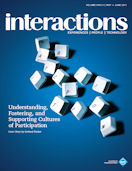Authors:
Gerhard Fischer
Cultures are defined in part by their media and their tools for thinking, working, learning, and collaborating. In the past, the design of most media emphasized a clear distinction between producers and consumers [1]. Television is the medium that most obviously exhibits this orientation and has contributed to the degeneration of humans into "couch potatoes" [2], for whom remote controls are the most important instruments of their cognitive activities. In a similar manner, our current educational institutions often treat learners as consumers, fostering in students a mind-set of consumerism rather than of ownership of problems, which they carry with…
You must be a member of SIGCHI, a subscriber to ACM's Digital Library, or an interactions subscriber to read the full text of this article.
GET ACCESS
Join ACM SIGCHIIn addition to all of the professional benefits of being a SIGCHI member, members get full access to interactions online content and receive the print version of the magazine bimonthly.
Subscribe to the ACM Digital Library
Get access to all interactions content online and the entire archive of ACM publications dating back to 1954. (Please check with your institution to see if it already has a subscription.)
Subscribe to interactions
Get full access to interactions online content and receive the print version of the magazine bimonthly.







Post Comment
No Comments Found